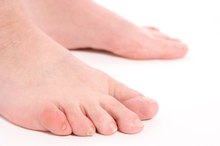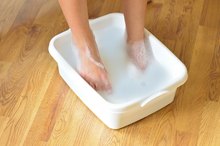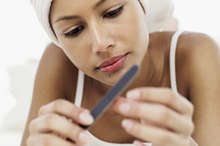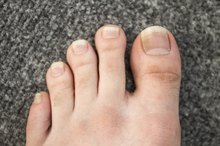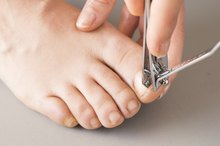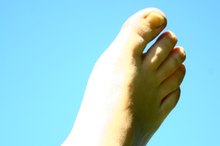Baking Soda for Ingrown Nail
Ingrown nails are a common problem, especially for the toes, and often a result of poorly fitting footwear or poor trimming technique. Ingrown nails damage surrounding tissue and lead to infection, inflammation and pain. Baking soda is an old folk remedy that displays antiseptic properties and is safe to use on a variety of skin infections. Consult with your doctor or a podiatrist if your ingrown nail becomes infected, because removal of a portion of the nail may be necessary.
If you are experiencing serious medical symptoms, seek emergency treatment immediately.
Ingrown Nails
An ingrown toenail, also known as onychocryptosis, is a common condition that involves your nail growing towards and cutting into the surrounding nail bed tissue, or paronychium. The paronychium becomes injured, which causes a localized microbial infection, inflammation and considerable tenderness, according to the book “General and Systematic Pathology.” The infectious agent is often bacterial, but can also include:
- fungi [1](# 'inline-reference::General
- Systematic Pathology; Paul Bass
- et al.')
Other common symptoms include redness, light bleeding, formation of a crusty granuloma, drainage of puss and extreme sensitivity to pressure.
Causes
Ingrown Thumbnail
Learn More
Improper cutting technique on any nail may cause it to grow towards the paronychium and pierce it if the edge of the nail is sufficiently sharp. Other contributing factors for the development of ingrown nails include trauma, diseases, deformities, nutritional deficiencies and genetics.
Baking Soda
Baking soda, or sodium bicarbonate, is used in a variety of cooking and health applications. According to Dr. Brent Bauer M.D., author of the “Mayo Clinic Book of Alternative Medicine,” baking soda is more effective against fungi than bacteria because:
- fungus
- yeast
- molds are more sensitive to changes in pH
- which is a measurement of acidity [4](# 'inline-reference::Mayo Clinic Book of Alternative Medicine - 2nd Edition; Brent Bauer
- M.D
').
Recommendations
Ingrown Toenail on the Pinky
Learn More
To reduce your risk of ingrown nails, wear shoes that fit properly and allow plenty of room for your toes. Further, try not to cut your nails too short or at uneven angles. Before applying baking soda to your fingernails or toenails, you should moisten it with some water and make it into a paste. Gently pack the bicarbonate paste into the injured tissue and cover the infected finger or toe with some sanitary gauze or bandage. If the infection persists or worsens, consult immediately with your doctor. In some cases, ingrown nails need to be removed and the infection treated with antibiotics.
- To reduce your risk of ingrown nails, wear shoes that fit properly and allow plenty of room for your toes.
- Gently pack the bicarbonate paste into the injured tissue and cover the infected finger or toe with some sanitary gauze or bandage.
Related Articles
References
- General and Systematic Pathology; Paul Bass, et al.
- Harrison's Principles of Internal Medicine; A. Fauci, et al.
- Biochemical Pathways; Gerhard Michal
- Mayo Clinic Book of Alternative Medicine - 2nd Edition; Brent Bauer, M.D.
- Dąbrowski M, Litowińska A. Recurrence and satisfaction with sutured surgical treatment of an ingrown toenail. Ann Med Surg (Lond). 2020 Jun 26;56:152-160. doi: 10.1016/j.amsu.2020.06.029. PMID: 32637092; PMCID: PMC7330155.
- Haneke E. Controversies in the treatment of ingrown nails. Dermatol Res Pract. 2012;2012:783924. doi: 10.1155/2012/783924. PMID: 22675345; PMCID: PMC3362847.
- Miquelão Canuto Verussa MJ, Biselli Boarini LM, Gabbi T. "Super U" technique for ingrown nails: a tertiary hospital experience between 2011 and 2018. Int J Dermatol. 2019 Oct 24. doi: 10.1111/ijd.14694. Epub ahead of print. PMID: 31650538.
- Arica IE, Bostanci S, Kocyigit P, Arica DA. Clinical and sociodemographic characteristics of patients with ingrown nails. J Am Podiatr Med Assoc. 2019 May;109(3):201-206. doi: 10.7547/17-023. PMID: 31268783.
- Mayeaux EJ Jr, Carter C, Murphy TE. Ingrown toenail management. Am Fam Physician. 2019 Aug 1;100(3):158-164. PMID: 31361106.
- Sánchez LC, Zalacaín-Vicuña AJ. Onychoplasty with 1064-nm Laser: Matrixectomy for Treatment of Ingrown Toenails. J Am Podiatr Med Assoc. 2019 Sep;109(5):401-406. doi: 10.7547/17-008. PMID: 31599675.
- Muriel-Sánchez JM, Becerro-de-Bengoa-Vallejo R, Montaño-Jiménez P, Coheña-Jiménez M. The treatment of ingrown nail: Chemical matricectomy with phenol versus aesthetic reconstruction. A single blinded randomized clinical trial. J Clin Med. 2020 Mar 20;9(3):845. doi: 10.3390/jcm9030845. PMID: 32244966; PMCID: PMC7141528.
- American Academy of Family Physicians. Ingrown toenails. January 4, 2018.
Writer Bio
Sirah Dubois is currently a PhD student in food science after having completed her master's degree in nutrition at the University of Alberta. She has worked in private practice as a dietitian in Edmonton, Canada and her nutrition-related articles have appeared in The Edmonton Journal newspaper.

